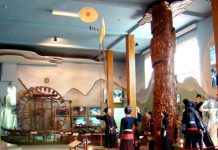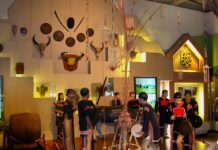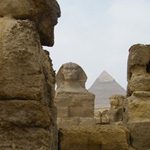|
Ethnic groups of the H’mông – Dzao, KaĐai and Tibeto – Burman language group live alternately in provinces along the VietNam – China and VietNam – Laos bosders, from East to West, from Quảng Ninh, Lạng Sơn, Cao Bằng, Hà Giang, Lào Cai, Lai Châu, Sơn La to Thanh Hoá, Nghệ An and some mountainous districts of Bắc Kạn, Thái Nguyên and Tuyên Quang provinces.
|
|
Their settlements are mainly in high mountain areas and middle land, closely related to forest and mountainous environment where the landscape is full of obstacle and difficult to access. It is difficult to transport commodidies in these places, so economy is not developed enough.
* The group of H’mông – Dzao language family has 03 ethnic groups: H’mông, Dzao and Pà Thẻn The H’mông includes groups of White H’mông, Flower H’mông, Red H’mông, Black H’mông and Green H’mông. The Dzao includes groups of Red Dzao, Tight-trousers Dzao, Dzao Lô Gang, Coin Dzao, White-trousers Dzao, Indigo-clad Dzao and Dzao Làn Tiển. Each group has various small branches. The Pà Thẻn people emigrated to the Vietnam about 200 – 300 years ago. The group of Ka Đai language family has 04 ethnic groups: La Chí, Cờ Lao, Pu Péo and La Ha The group of Tibeto – Burman language family has 06 ethnic groups: Lô Lô, Hà Nhì, La Hủ, Phù Lá, Cống and Si La * Exhibition topic No. 1: Mountainous villages and houses The villages of H’mông – Dzao and Tibeto – Burman people are mainly built on high mountains or mountain slopes with airy and cool climate, but scarce water and difficult to access. Some groups of La Chí, Cống, Si La and some Dzao groups set up their villages along the rivers, streams or at places favourable for bringing water to their homes. There are two types of villages: scattered and concentrated. The number of houses in a village depends on specific terrain and the settled or shifting cultivation of each ethnic minority. Ethnic groups of the H’mông – Dzao, Ka Đai and Tibeto – Burman language family have three types of houses: ground-floor houses, half-ground half-stilt houses and houses on stilts. Ground-floor houses are often seen in most of H’mông – Dzao and Tibeto – Burman groups. Houses on stilts are often seen in the Dzao with wet rice cultivation, some Dzao people cultivating milpas such as Indigo-clad Dzao, Long-tunic Dzao, a part of Lô Lô, Phù Lá and the major part of Cống and Si La people. Half-ground half-stilt houses are often seen in two groups of Dzao in the middle land in North Vietnam, La Chí and a part of Lô Lô people. *Exhibition topic No. 2: Agriculture Ethnic groups of H’mông – Dzao, Ka Đai and Tibeto – Burman language family mainly cultivate milpas. There are three types of milpas: milpas using hoes and ploughs play an important role, closely retated to the settled cultivation of most ethnic minorities in three groups. The slash and burn milpa is attached to shifting cultivation which only exists in some local groups. People also make use of the terrain and holes in rocks to cultivate. On milpas, people grow rice, maize, barley, vegetable, bean, pumpkin, pea, edible canna, medicine hebs, fruit trees and industrial trees. Their tools of production include crowbars, machetes, hoes, ploughs and rakes etc. The plough of people in the high mountainous area has strong, big and short body, suitable for rocky mountain milpa. Together with milpa cultivation, in their settlement process, people have made use of the terrain to exploit and built embankment to create terraced fields to cultivate wet rice. Depending on the terrace, people create high or low, broad or narrow terraced fields. Therefore, some are only 1m, or even some dozen cm, some are 2 – 3 ploughing lines while others only one ploughing line. In wet rice cultivation, people in high mountainous area also know how to create canal to irrigate, and work well the land, plough and harrow many time to annihilate weeds, increasing fertility to have high productivity. * Exhibition topic No. 3: Hunting Hunting and gathering aim at improving the life and protecting crops for people in mountainous area. Today, these activities are still maintained, however not so frequently like before. The H’mông, Dzao, Phù Lá and La Hủ people are very good in hunting small animals such as wild boar, musk-cat, deer, monkey, fox and weasel. Most of ethnic minorities’ men know how to make various traps and crossbow. Some of them are good at forging, drilling, making matchlock and effective traps to catch wild animals. Moreover, people are also good in fishing by many ways: drug, bamboo fence, trap, their hands and casting net etc. * Exhibition topic No. 4: Gastronomy custom of ethnic groups of H’mông – Dzao, KaĐai and Tibeto – Burman language family. Most of people in Hmông – Dzao, KaĐai and Tibeto – Burman group often have two main meals a days in the morning and evening. Only some Dzao groups consider lunch and dinner as their main meals. Some ethnic groups of H’mông, Pu Péo and Lô Lô eat “mèn mén” of steamed maize as their staple food. Maize is ground into flour, mixed with water then put into a steamer to cook through then spreaded on a large and flat bamboo basket, sprayed with water, mixed then steamed once again so that it would be quite done. Formerly, some ethnic groups ate glutinous rice, but now they eat ordinary rice, some of them mix rice with maize and cassava. Glutinous rice is only used for steamed glutinous rice and cakes in rituals and Lunar New Year Festival. Their daily foods include: bamboo shoot, vegetable, bean and pumpkin etc. In Festivals there are chicken, goat meat, pork, beef and fish. Apart from frying, cooking and boiling meat, people also dry, smoke, and ferment meat for long-term use. Thắng cố is a peculiar food of the mountainous people, prepared by simmering for hours a hotchpotch of meat, bone and intestine of various cattle. In a periodic market, the H’mông also have a kind of cake by grinding young maze into a thick liquid like milk to make floating cakes. People often drink wine. Only the Indigo-clad Dzao, Coin Dzao, Lô Lô and Phù Lá people drink hoẵng wine. The daily drink is tea, eugenia leaves and forest leaves. They smoke tabaco by hubble-bubble, and in some areas, people chew betel. * Exhibition topic No. 5: Carpentry and forgering Almost all men of the H’mông, Dzao and La Hủ ethnic groups can forge knife, hoe and spade etc., and repair agricultural tools. Especially the steel tempering technique of the H’mông and La Hủ achieves high level. People can drill steel bar to make matchlock barrel. Carpentry is rather popular in daily life of the H’mông and Cờ Lao. By only a simple turning table, they can produce very beautiful wooden pots and utensils such as soup ladle, spoon, bowl and basin etc. * Exhibition topic No. 6: Weaving The use of bamboo and rattan to make household utensils has developed in almost all ethnic groups in Hmông – Dzao, KaĐai and Tibeto – Burman language family. The weaving products of the H’mông and Cờ Lao are well-known, including flat big basket, bamboo mat, bamboo wattle, large baket and papoose etc. Men and women of the Cống, La Chí and Phù Lá know how to weave papoose, food containers and clothes containers by bamboo and rattan with very beautiful designs on them. The La Hủ are very good in weaving meal trays and rattan chairs. In general, their weaving products not only serve their self-subsistence life but also become a commodidy for exchanging with neighbouring ethnic groups. * Exhibition topic No. 7: Weaving fabric, printing patterns and embroidery thêu thùa All of the H’mông, Dzao, Pà Thẻn, La Chí, La Ha and Phù Lá ethnic groups maintain and develop weaving fabric to meet a part of their wearing demands. H’mông women are very good in weaving fabric by flax (except that the groups of Green H’mông, H’mông Súa and Na Miẻo plant cotton to weave fabric). According to H’mông custom, a dead person has to wear a flax blouse so that his soul can meet with its ancestors. Therefore, every young girl from 15 upwards must have a flax field. Flax is often grown along the foot of a mountain and in valley in about Lunar April. After 3 – 4 months, it is cut into bunches to dry about 10 – 15 days. Then people strip its bark before the northeast monsoon comes, because in cold wind, flax threads would be dry and less durable, easy to be rotten and difficult to connect them. The flax barks are peeled off, divided into even small bunches and pounded to make them soft and frayed, then every fibre is striped and connected together, rolled up into big reels, steeped in ash water, boiled, washed up, boiled again in water and wax for 4 – 5 hours, taken out to drain, then use a round wooden bar to crush many times to make the fibres shining and durable. Then weave the fibres into threads and put onto the loom. H’mông women always bring with them the flax barks, whether going to the market or resting by the milpa. They take advantage of every leisure time to strip fibres and connect them. Before putting onto the loom, people use a reel to make thread. After weaving, fabric is boiled in filtered ash water to become white, stiffened by wax to make it shining, then dye with indigo. There is loom in every H’mông family. Each year, a woman can weave from 4 – 5 flax fabric piecies, each one 20 squares of cloth, enough to make a beautiful suit. The most simple tools to print patterns include printing brushes of different sizes (some for straight lines and edging lines; some for painting flowers and leaves; others specialized in making circles), the triangle bamboo frames, bowl containing wax and flat basket to prop the printing. * Printing technique: Heat the wax to melt it, then dip a side of a triangle frame or a brush into it then print on the fabric. It depends on the length of the straight line to choose the suitable frame. For printing circles, use small bamboo tube with appropriate cross section. After printing, dye the fabric many times until it has dark colour, dip it into warm water to melt wax, leaving on it very beautiful light blue and white patterns. Embroidery and making fabric patterns are unique cultural identities of H’mông – Dzao women. They have a special and clever way of embroidery, creating patterns not based on previously painted models, but thoroughly on their memory and imagination. Their embroidery technique is applying embroidery needles on the reverse of the fabric to make the patterns appear on its right side. Therefore, before embroidering, the woman has to carefully consider every needle-work, remember the size of every part in the pattern to create a general pattern plan with balanced and harmonious disposition, having highly aesthetic features in their costume. The popular patterns are the shapes of buffalo horns, snails, swasticas and hooks etc., closely related to landscape and ethnic conceptions. * Exhibition topic No. 8: Wedding customs Ethnic groups of H’mông – Dzao, Ka Đai and Tibeto – Burman language family practice monogamy and long-lasting marriage. There are few cases of polygamy and divorce. In previous regime, their marriages were a financial arrangement of buying and selling. Today, boy and girl get to know each other to decide their marriage. Marriage between people of the same family is prohibited. The main rituals in marriage of ethnic groups include: sending word, offering marriage, betrothal and wedding. However, there are different rituals for each group and ethnic group. Among the Dzao, there must be the comparison of boy and girl’s ages and watching the chicken legs to see whether they are harmonious to decide marriage. The wedding is often held one year or a shorter period after the betrothal ceremony, depending on each group or locality. During this time, the bridegroom stays at home to weave fabric, do embroidery and sewing clothes to prepare for her dowry. Only the Red Dzao has not the custom of receiving the bride. The bride is received and brought to the bridegroom’s family by his parents, siblings, cousins and his family’s representative. When the bride arrives at the bridegroom’s to carry out the Tơ hồng (wedding) ceremony (the Dzao also call it “Hồng Toòng” ceremony), she has to cover her head with a red scalf decorated with small cotton balls and tassels, step over a water basin on which a sorcerer had applied magic. Only after ancestral ceremony, she could put off the scalf. “Hồng Toòng” is set up at the ancestor alter, similar to a triumphal arch, and pasted up with colour paper and parallel scrolls. The sorcerer puts a red string or cloth band across the bride and bridegroom’s shoulders, and reads a book on marriage and business of the Dzao, praying to the ancestors for approving the wedding. * Exhibition topic No. 9: Giving birth Women in ethnic groups of H’mông – Dzao, Ka Đai and Tibeto – Burman language family give birth with the support of a village midwife or mother-in-law, sister-in-law. Before and after giving birth, the mother should abstain from many things. About one week right after the baby is born, the family puts up some signs to warn others against entering the house: the La Hủ put a conical hat on a a take, the La Ha set up a hexagone-pattern trellis, and the La Chí hang a bunch of green leaves in front of the door etc. to keep the new-born baby’s spirit. They are afraid of strangers with bad spirits which could make the baby often cry and don’t want to eat. Only when the baby is one month old, the family put off these signs. The people have the custom of burying placenta or put it in a basket and hang on a branch of tree with the hope that the baby would be healthy. * Exhibition topic No. 10: Funeral Ethnic people in mountainous areas think that to die means to live in the afterworld. That is why funeral is organized with a complicated ritual to send the soul of the dead person to “his homeland”, the blissful world. This ritual also means that everybody “shares enjoyments with the dead person for the final time” and a decrease of sorrow for the family of the dead. Some ethnic groups of Dzao, Pu Péo and Cờ Lao have the custom of organiging vegetarian party in funeral. It depends on economic conditions of the family, the Lô Lô organise the “dry ghost” ceremony 13 days or 3,5,7 years after the “fresh ghost” one for the salvation of the deceased’s soul. They make a dummy wearing traditional attire to represent the dead person. Moreover, there is a piece of fabric for him below the ancestor alter. The sorcerer prepares a lot of votive money and uses properties: cymbals, castanets, sword, yin-yang card and brass drum to beat time for folk dancing. In the ceremony praying to ancestors to receive the dead person’s soul and their offerings, the people strike drum and dance to see off the deceased to ancestors’ land in the afterworld. In “dry ghost” ceremony, the Lô Lô in Mèo Vạc, Hà Giang eat mèn mén (maize cake), drink wine, dance and sing the traditional songs. * Exhibition topic No. 11: cấp sắc (conferring a title) ceremony of the ethnic Dzao It is a very important ceremony of the Dzao. According to the ethnic Dzao Tien’s concept, all matured men should have cấp sắc ceremony with three lamps. The sorcerers also carry out many times of cấp sắc with different numbers of lamps, from 3, 7, 9 etc. These ritual bear many hallmarks of Taoism and the aged-old customs that signified a manhood. The “tam linh” (3 lamps) cấp sắc ceremony of the Tight-trousers Dzao is held in front of the ancestor alter. There must be a set of worshipping pictures (“Tam thanh” “hành sư” and “hành phây”) including 24 pages and various properties: oil lamps, staffs, yin-yang cards, snail horn, drum, brass bell, percussion, permission card, chair for offering slaughtered pig, and a chair for the man who is conferred the title of maturity. The matured man in the 3 lamps cấp sắc sit on the chair. Three sorcerers, who are invited to conduct the ceremony should have experienced the cấp sắc ceremonies from 7 lamps upwards, all are older the matured man. They carry out the ceremony of offering lamps at the alter, then place the lamps at different positions over the man’s body: the first sorcerer places a lamp on his head, the second on the right shoulder and the third on the left shoulder. The man must sit for hours to endure the heat of three lamps while a sorcerer reads two paper scrolls written with the identity of the man to report to ancestors and deities. After that, he burns the “yin” copy to sent to the ancestors, the “yang” one would be kept by a ritual aid. When the man die, he would use this copy as a passport to come to meet his ancestors in the other world. * Exhibition topic No. 12: Market culture in mountainous areas Transport experiences major difficulties in high mountainous areas. The H’mông – Dzao, Kađai and Tibeto – Burman people often self-support most of their requirements, so they seldom go down the mountain. Generally, every 1-2 weeks or even one month, the couples would go down to the market. The market is often held on Sunday. Streams of people with colourful attires from different directions pour into the market. Some carry goods, others lead pigs or pack-horses, each group about 5-7 people going along trails winding along mountain slopes, hurrying to the market. At the periodic market, people sell all their products from cattle, poultry, forest products to medicine herbs. And they buy all necessities for their living: oil, salt, embroidery threads, tobacco, hoes, knives, axes, pans, bowls, dishes, tea pot and cup etc… Market is not only the place for buying and selling, exchange of commodities, but also the meeting place of relatives and young people, the place of entertainment, communication with somebody, learning, playing clarinets and flutes to find one’s spouse. They invite one another to eat thắng cố, mèn mén, drink wine to forget their hard-working days before “going up the mountain to come back home”. The drunken are considered as those who have many friends, so a H’mông wife would patiently sit to connect flax fibres to wait for her husband without worrying. When her husband is sobered up, they would come back home. * Exhibition topic No. 13: Traditional herbal medicine In each ethnic group of the H’mông, Dzao – Kađai and Tạng miến language family, many people know how to find and process berbal medicine (artemisia, nut grass, amomum, formes japonicus, and ginseng etc…) to treat diseases. Formerly, these people always kept the secrets of the medicinal herbs, quietly went into the forest to gather simples and treated diseases together with their owned magics. Nowadays, people can multiply the herb plants and grow valuable medicine herbs such as: formes japonicus, star anisis and ginseng to use or sell to neighbouring people as well as pharmacies. * Exhibition topic No. 14: Folk literature, music and art Folk literature of the H’mông – Dzao, Ka Đai and Tibeto – Burman people is diversified and rich in types and contents, including: mythology, fairy tales, legends, epics, folk songs, proverbs, and parallel sentences etc… which praise the love for nature, life, the solidarity to fight against brutal power, condemn the injustice in the previous regime, state the misery of the servants, protect the love of the couples and ethnic customs. Ethnic folk music and art have many unique features with diversified musical instruments such as: khèn, flute, lip instrument, leaf clarinet, round guitar, two-string guitar and drum often seen in the H’mông; trumpet, 16-chord zither, flute, drum, gong, cymbals, castanets, and horn etc… often seen in the Dzao; group Khèn, tày nhạy guitar and bamboo flute of the Pà Thẻn; Drum, gong, 3 string tính guitar, khèn and flute often used among the La Chí and ethnic groups of Tạng – Miến people. Formerly, bronze drums were often played by the Pu Péo and Lô Lô. Today, they only appears in funeral of the Lô Lô (including the male and female ones) to see off the deceased’s soul to their ancestors People often organize collective dancing and singing, folk games such as còn throwing, see-saw, swings, blowing khèn, and walk on stilts in festivals and Lunar New Year. Singing in betrothal and wedding ceremonies for 3 – 4 hours has become an unique art activity of many ethnic groups, among which the songs “becoming a daughter-in-law” of the H’mông, “Ni ca” of the La Chí, and dances of La Hủ people are very special. |
Home
Introduction
Display system Showroom No. 3 CULTURES OF ETHNIC GROUP OF H’MONG –DZAO, KADAI AND...

















